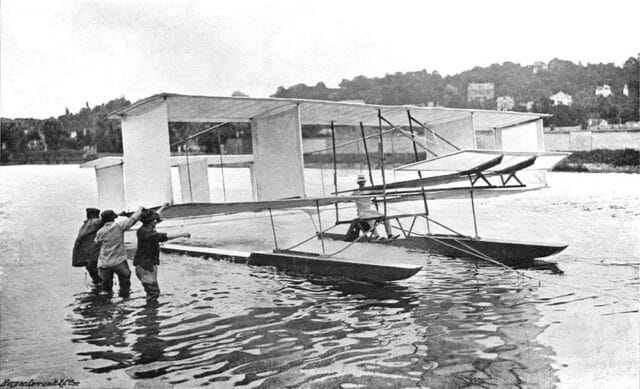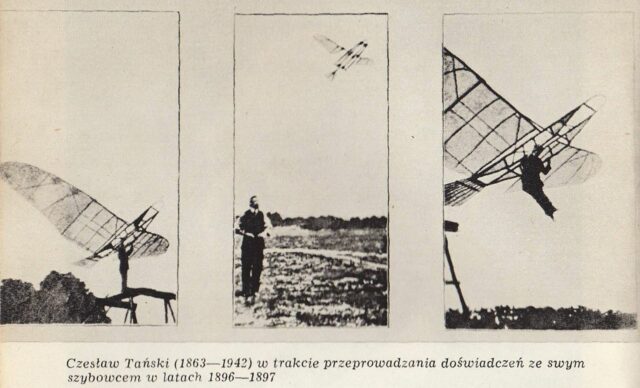The Oldest Footage of Flight
About a week ago, Marléne Aviation posted to Twitter in an attempt to find the oldest video footage of a flight. Marléne Aviation is run by a French aviation history enthusiast. They posted a video of the Archdeacon-Voisin hydro-planeur test on the Seine along with the request.
Do you know of a film of an aircraft older than 1905? I went looking for the oldest video of a flight and this is the best I could find. This is the Archdeacon-Voisin hydro-planeur test on the Seine. pic.twitter.com/b6GNFKROG6
— Marlène Aviation (@AviationMarlene) August 29, 2022
Gabriel and Charles Voisin pioneered aviation in France. Their lifelong obsession with flight started in 1903, when Ernest Archdeacon hired Gabriel to build gliders. The video that Marléne Aviation posts is from a test run on the result, taken on the 8th of June 1905 in which the hydroglider flew for 150 metres at a height of 50 feet.

That same year, Gabriel formed a commercial aircraft manufacturing company with Louis Blériot. In 1907 he reformed it in partnership with his brother; they released the company’s first successful aircraft the same year, now known as the classic Voisin pusher biplane. A military version of the same design was released in 1912, with over 3,500 Voisin aircraft produced during the war for reconnaissance, artillery spotting and bombing. The first recorded aerial victory of the war took place in a Voisin 3 which downed a German aircraft with its on-board machine gun.
Would there be anything older than this 1905 video, I wondered?
Almost immediately, someone responded to Marléne Aviation with a YouTube clip of the Wright Brothers. The video starts with a claim that the footage was taken in 1903.
It’s true that the Wright Brother’s first powered flight was in December 1903. However, the aircraft shown in the YouTube clip is not the same aircraft. The first flights were in aircraft designed to mimic contemporary gliders which had the pilot lying on his stomach.

However, in the YouTube clip, the pilot is sitting upright, which proves it was in an aircraft which was designed at the earliest in 1905.
Marléne Aviation was not fooled and identified the video as a demonstration flight from 1908.
Several people responded to the original query with descriptions of footage which has been lost.
Heinrich Dubel tells of a film by the Brothers Skladanowsky of the maiden flight of Hermann Ganswindt’s helicopter in Berlin in July of 1901, in which the aircraft rose for several seconds while carrying two people and then gently sank back to the ground. The film was shown publicly in Berlin.
This is believed to have been the first manned motor-driven flight in the world. At the time, though, it soon came under a shadow. It turned out that a cable (or a bar?) had been connected to the helicopter, which led to accusations that the flight had been faked.
Ganswindt was arrested for fraud. He argued that this was only for safety and that the helicopter rose off the ground under its own power. He was released eight weeks later when a further flight demonstration proved that he was telling the truth, but by then, his reputation and his fortune had been ruined.
To add insult to injury, the footage that so many people watched in Berlin disappeared and was never seen again.
A Twitter account known as the Balloon Archives referred to a film by George Meliés called The Catastrophe of the Balloon “Le Pax”, which are presumed lost. They also posted this video which was taken in 1897-1898. It doesn’t quite fit the bill as it does not show the balloon in flight but rather is taken from a tethered balloon.
Aɍɛκ βɛκiɛɍsƶ posted a still photo of an early unpowered flight by Czesław Tański, considered the father of Polish aviation. He constructed a glider based on his observations of birds and insects, hoping to carry out the first manned flight of a heavier-than-air aircraft on Polish soil. The glider weighed 18 kilograms, with a wingspan of 8 metres. Tański jumped from a 3.5 metre-high scaffold and managed to glide for about 30 metres. Over the next three years, he repeated the flight in front of witnesses, including the Army who photographed this series of images in 1896 or 97. The rapid development of manned flight in the years that followed quickly outstripped his ideas and he was unable to continue to contribute to Polish aviation. Nevertheless, these flights were spectacular for their time.

This is much earlier than the other examples of manned flight. However, Marléne Aviation asked for video, not stills, even though they are in a sequence.
Finally Thanos Maasias posted what seems to be the winner.
Percy Pilcher was a British inventor who became interested in aviation in 1890. Pilcher designed a hang glider called Bat which he demonstrated in 1895, the same year as Tański flew his glider in Poland. He may not have been the first pilot in the UK but he was the first to make repeated flights.
Pilcher entered correspondence with Otto Lilienthal, a German aviation pioneer who is credited with the very first glider flight in the world. Lilienthal’s gliders led Pilcher to use winglike structures to produce lift. Taking advantage of this new technique, he designed a new glider, Hawk, with which he flew 250 metres (820 feet), breaking the world distance record.
This footage is all that remains of a film made on the 20th of June 1897. It is just seven frames and looks to be the oldest footage of manned flight that Marléne Aviation was looking for.
Pilcher went on to design a triplane powered by a four HP engine. He invited onlookers for the triplane’s maiden flight on the 30th of September 1899. However, the engine’s crankshaft had broken and he decided to fly Hawk instead so that the attendees would not be disappointed. The tail snapped after Hawk’s structure came under too much strain in the rain, and Pilcher fell ten metres to his death.
In 2003, Cranfield University’s School of Aeronautics built the aircraft and the engine based on Pilcher’s plans. They found that the triplane did fly: on its maiden flight, the triplane remained in sustained flight for one minute and twenty-five seconds in calm winds, which was twenty-six seconds longer than the Wright Brother’s best flight at Kitty Hawk in 1903, which took place with a 20 mph headwind to increase the airspeed.
Special thanks to Marléne Aviation for that unexpected exploration into early flights and film.








So sorry for the late post. I am run off my feet this week and next — I set this to send itself but apparently it needed some hand-holding. Regular service will be resumed shortly!
It was worth the wait! What a fascinating account. Thanks for your continuing investigations.
Thank you Sylvia, indeed I agree with AndrewM: worth waiting for!
The oldest books about aviation in my own collection (“Library”) date from around 1910, but I have an older book in French describing a fictional flight with an airship.
And I possess a few photos (originals, not copies) from about 1919 of a Dutch naval aviation aircraft. Sadly they were taken after it crashed during a training flight. The instructor was killed. I also have his crash helmet an a piece of a wing strut with the airspeed indicator still attached, as well as a copy of a magazine with an “In Memoriam” about the pilot.
But no moving images, no film. And certainly not that old either.
This claims to show stills of the first powered flight on 17 Dec 03 in a modified glider called the “Wright Flyer”, or “Flyer One”, with the pilot prone on the aircraft.
Yes, the stills in that video have the right landscape for the 1903 flight and as you note, the pilot is lying face down. I don’t think there’s any moving footage of that first flight.